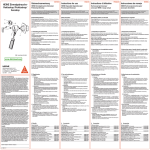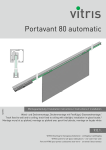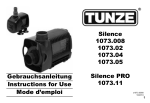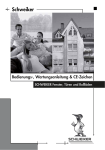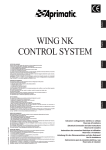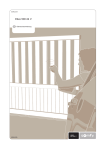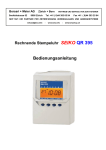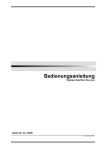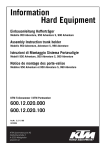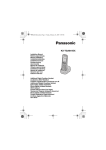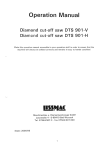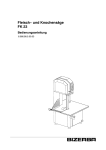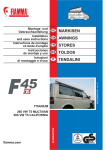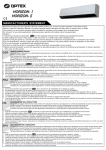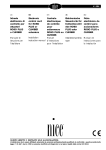Download MANUAL MECANICO WING NK
Transcript
Italiano MODULO WING NK Français English WING NK MODULE MODULE WING NK MODULO WING NK MÓDULO WING NK SCOPO DEL MANUALE Questo manuale è stato redatto dal costruttore ed è parte integrante del prodotto. In esso sono contenute tutte le informazioni necessarie per: • la corretta sensibilizzazione degli installatori alle problematiche della sicurezza; • la corretta installazione del dispositivo; • la conoscenza approfondita del suo funzionamento e dei suoi limiti; • il corretto uso in condizioni di sicurezza; La costante osservanza delle indicazioni fornite in questo manuale, garantisce la sicurezza dell’uomo, l’economia di esercizio e una più lunga durata di funzionamento del prodotto. Al fine di evitare manovre errate con il rischio di incidenti, è importante leggere attentamente questo manuale, rispettando scrupolosamente le informazioni fornite. Le istruzioni, i disegni, le fotografie e la documentazione contenuti nel presente manuale sono di proprietà APRIMATIC S.p.a. e non possono essere riprodotti in alcun modo, né integralmente, né parzialmente. Il logo “APRIMATIC” è un marchio registrato di APRIMATIC S.p.a. Deutsch PURPOSE OF THE MANUAL This manual was drawn up by the manufacturer and is an integral part of the product. It contains all the necessary information: • to draw the attention of the installers to safety related problems • to install the device properly • to understand how it works and its limits • to use the device under safe conditions Strict observance of the instructions in this manual guarantees safe conditions as well as efficient operation and a long life for the product. To prevent operations that may result in accidents, read this manual and strictly obey the instructions provided. Instructions, drawings, photos and literature contained herein are the exclusive property of the manufacturer and may not be reproduced by any means. The “Aprimatic” logo is a trademark registered by Aprimatic S.p.A. Cod. B1283000 - rev. 0 - ottobre 2004 ZWECK DES HANDBUCHS Dieses Handbuch wurde vom Hersteller verfasst und ist ein ergänzender Bestandteil des Produkts. Es enthält alle nötigen Informationen für: • die Sensibilisierung der Monteure für Fragen der Sicherheit; • die vorschriftsmäßige Installation der Vorrichtung; • die umfassende Kenntnis ihrer Funktionsweise und ihrer Grenzen; • die vorschriftsmäßige und sichere Benutzung. Die Beachtung der in diesem Handbuch enthaltenen Anweisungen gewährleistet die Sicherheit der Personen, den wirtschaftlichen Betrieb und eine lange Lebensdauer des Produkts. Zur Vermeidung von Fehlbedienung und somit Unfallgefahr dieses Handbuch aufmerksam durchlesen und die Anweisungen genau befolgen. Die Anleitungen, Zeichnungen, Fotos und Dokumentationen in diesem Handbuch sind Eigentum von APRIMATIC S.p.A. und dürfen in keiner Weise ganz oder teilweise reproduziert werden. Das Logo „Aprimatic“ ist ein eingetragenes Warenzeichen der Aprimatic S. p. A. OBJETO DEL MANUAL Este manual ha sido redactado por el constructor y forma parte integrante del producto. El mismo contiene todas las informaciones necesarias para: • la correcta sensibilización de los instaladores hacia los problemas de la seguridad • la correcta instalación del dispositivo • el conocimiento en profundidad de su funcionamiento y de sus límites • el correcto uso en condiciones de seguridad La constante observación de las indicaciones suministradas en este manual, garantiza la seguridad del hombre, la economía del ejercicio y una mayor duración de funcionamiento del producto. Con el fin de evitar maniobras equivocadas con riesgo de accidente, es importante leer atentamente este manual, respetando escrupulosamente las informaciones suministradas. Las instrucciones, los dibujos, las fotografías y la documentación que contiene este manual son propiedad de APRIMATIC S.p.a. y no pueden ser reproducidas en ninguna manera, ni integral ni parcialmente. El logotipo “Aprimatic” es una marca registrada de Aprimatic S. p. A. Español BUT DU MANUEL Ce manuel a été rédigé par le constructeur et fait partie intégrante du produit. Il contient toutes les informations nécessaires pour : • sensibiliser les installateurs aux problèmes liés à la sécurité ; • installer le dispositif de manière correcte ; • connaître le fonctionnement et les limites du dispositif ; • utiliser correctement le dispositif dans des conditions de sécurité optimales ; Le respect des indications fournies dans ce manuel garantit la sécurité personnelle, une économie de fonctionnement et une longue durée de vie du produit. Afin d’éviter des opérations incorrectes et de ne pas risquer des accidents sérieux, lire attentivement ce manuel et respecter scrupuleusement les informations fournies. Les instructions, les dessins, les photos et la documentation contenus dans ce manuel sont la propriété d’APRIMATIC S.p.A. et ne peuvent être reproduits sous aucune forme, ni intégralement, ni partiellement. Le logo « Aprimatic » est une marque déposée par Aprimatic S.p.A. Istruzioni per l’istallazione meccanica Riservate all’installatore Mechanical installation instructions Reserved for installers Instructions pour le montage mécanique Réservées à l’installateur Anleitung für die mechanische Installation Nur für Installateure Instrucciones para la instalación mecánica Reservadas para el instalador Italiano SOMMARIO 1. Premessa al manuale istruzioni .................................................................................. 2 2. Avvertenze generali di sicurezza ................................................................................ 3 3. Uso previsto e campo di impiego................................................................................ 3 4. Dati tecnici..................................................................................................................... 4 5. Componenti del Modulo ............................................................................................... 4 6. Accessori obbligatori ................................................................................................... 4 7. Installazione Modulo e Puleggia.................................................................................. 5 7.1 Posizionamento Modulo e Puleggia.................................................................................... 6 1. PREMESSA AL MANUALE ISTRUZIONI Informazioni Le presenti istruzioni riguardano esclusivamente l’installazione meccanica del MODULO WING NK e della puleggia folle. Consultare le istruzioni fornite in allegato: • SISTEMA TRAVE NK (per la preparazione della trave); • WING NK CONTROL SYSTEM (per gli allacciamenti). ! Attenzione Nel corso delle operazioni di assemblaggio e montaggio dell’automatismo e di collaudo della porta si possono verificare situazioni di pericolo se non si osservano le avvertenze di sicurezza contenute nelle istruzioni. Prima di procedere LEGGERE attentamente il presente Manuale istruzioni. RENDERE DISPONIBILI LE ISTRUZIONI PRESSO L’IMPIANTO PER OGNI NECESSITA’ DI UTILIZZO E MANUTENZIONE. Cautela I dati riportati sono da ritenersi puramente indicativi. Il costruttore declina ogni responsabilità per le possibili inesattezze contenute nel presente manuale derivanti da errori di stampa o di trascrizione. L’azienda si riserva il diritto di apportare modifiche atte a migliorare il prodotto senza preavviso. SIMBOLI UTILIZZATI GLOSSARIO Il manuale istruzioni utilizza diffusamente termini tecnici adeguati ai professionisti dell’area tecnica ai quali è destinato. Il seguente glossario precisa il significato specifico con cui alcuni termini vengono utilizzati nel testo: Automazione ..............insieme assemblato di tutti i componenti meccanici, elettricoelettronici e strutturali in grado di fornire e controllare il movimento automatico del dispositivo di apertura/ chiusura specifico (porte, finestra, cancello, sbarra). Trave o Traversa.........struttura di supporto di tutti i componenti dell’automazione e delle ante di PORTE SCORREVOLI. Monoanta destra .........identifica l’automazione costituita da una sola anta scorrevole con APERTURA A DESTRA (per un osservatore che si trovi all’interno). Monoanta sinistra .......identifica l’automazione costituita da una sola anta scorrevole con APERTURA A SINISTRA (per un osservatore che si trovi all’interno). Vano di passaggio.......spazio reso utile per il passaggio in condizione di porta aperta. Sormonto....................spazio di sovrapposizione dell’anta sulla parete, dovuta alla maggior ampiezza dell’anta rispetto al vano di passaggio. I simboli utilizzati nel testo hanno il seguente significato: ! Attenzione Questo simbolo precede le avvertenze importanti per la SICUREZZA delle persone e dell’ambiente. Cautela Questo simbolo precede le avvertenze importanti per l’integrità del PRODOTTO e di beni materiali ad esso collegati. Informazioni Questo simbolo precede INFORMAZIONI ritenute particolarmente utili. -2- Avvertenze di sicurezza / Utilizzo e limiti di impiego 2. AVVERTENZE GENERALI DI SICUREZZA ! Attenzione I materiali dell’imballaggio (plastica, polistirolo, ecc.) non vanno dispersi nell’ambiente e non devono essere lasciati alla portata dei bambini in quanto potenziali fonti di pericolo. E’ vietato utilizzare il prodotto per scopi diversi da quelli previsti o impropri. E’ vietato manomettere o modificare il prodotto. LA NON CORRETTA INSTALLAZIONE DEL MODULO PUO’ PROVOCARE GRAVI PERICOLI, SEGUIRE ATTENTAMENTE TUTTE LE ISTRUZIONI PER L’INSTALLAZIONE. L’installazione deve essere eseguita da personale professionalmente competente. Si raccomanda di lavorare nel pieno rispetto delle norme di sicurezza; di operare in ambiente sufficientemente illuminato e idoneo per la salute; di indossare indumenti di protezione a norma di legge (scarpe antinfortunistiche, occhiali di protezione, guanti ed elmetto) evitando di indossare articoli di abbigliamento che possano impigliarsi. Adottare misure di protezione adeguate al rischio di ferita dovuto a schegge acuminate e ai possibili rischi di schiacciamento, urto e cesoiamento. Delimitare il cantiere per impedire il transito a persone non autorizzate e non lasciare incustodita la zona di lavoro. A causa di parti mobili traslanti e rotanti, quando il carter di copertura è smontato o aperto, vi è pericolo di trascinamento di capelli, indumenti, cavi ecc. Si raccomanda di osservare rigorosamente le norme nazionali valide per la sicurezza nei cantieri (in Italia D. Lgs. 528/99 coordinato con D. Lgs. 494/96 “Attuazione della Direttiva 92/57/CEE concernente le prescrizioni minime di sicurezza e di salute da adottare nei cantieri temporanei o mobili”). Installazione, collegamenti elettrici e regolazioni devono essere effettuati nell’osservanza della BUONA TECNICA e in ottemperanza alle norme vigenti nel paese di installazione. Il costruttore della motorizzazione non è responsabile dell’inosservanza della Buona Tecnica nella costruzione della struttura da motorizzare, né delle deformazioni che dovessero intervenire nell’utilizzo. Un’errata installazione può essere fonte di pericolo. Eseguire gli interventi come specificato dal costruttore. Prima di iniziare l’installazione, verificare l’integrità del prodotto e verificare che la struttura esistente abbia i necessari requisiti di robustezza e stabilità. Informazioni Il collaudo e la messa in funzione dell’automazione non sono consentiti fino a quando non sia stato verificato che la porta automatica scorrevole in cui essa è incorporata è conforme ai requisiti imposti dalla DIRETTIVA MACCHINE 89/392/CEE, alla quale la porta completa, montata e installata è assoggettata. L’installatore è tenuto a produrre e conservare il FASCICOLO TECNICO della porta automatica e deve ottemperare a tutti gli adempimenti previsti. Deve eseguire l’analisi dei rischi e verificare che l’impianto di porta scorrevole non presenti punti di schiacciamento o cesoiamento. Se necessario deve adottare adeguate misure correttive e applicare le segnalazioni previste dalle norme vigenti per individuare le zone pericolose. Ogni installazione deve riportare in modo visibile l’indicazione dei dati identificativi del sistema motorizzato. L’installatore deve fornire tutte le informazioni relative al funzionamento automatico, manuale e di emergenza della porta motorizzata e consegnare le istruzioni d’uso all’utilizzatore dell’impianto. Per eventuali riparazioni o sostituzioni dovranno essere utilizzati esclusivamente ricambi originali. Non si riconosce la garanzia in caso di utilizzo combinato con componenti di altra marca. Il costruttore della motorizzazione declina ogni responsabilità qualora vengano installati componenti incompatibili ai fini della sicurezza e del buon funzionamento. 3. USO PREVISTO E CAMPO D’IMPIEGO Il Modulo costituisce la base per realizzare con semplicità e rapidità una vastissima gamma di porte automatiche finite in quanto fornisce i componenti fondamentali dell’automazione preassemblati su un unico supporto. Il Modulo WING NK è stato progettato e prodotto esclusivamente per l’impiego su porte automatiche con una o due ante scorrevoli in orizzontale realizzate col Sistema trave NK Aprimatic. È destinato all’utilizzo in ambito civile, pubblico o industriale; in ambienti asciutti; in zone coperte d’ingresso e transito pedonale. ! • • • Il collegamento, il collaudo e la messa in funzione della chiusura pedonale, così come le verifiche periodiche e gli interventi di manutenzione, possono essere eseguiti soltanto da tecnici specializzati e formati sul prodotto. E’ necessario seguire un corso di specializzazione. A questo scopo gli installatori sono invitati a contattare il fornitore. Al termine del lavoro l’installatore deve verificare l’installazione e il corretto funzionamento dell’automazione. -3- Attenzione È vietato utilizzare il prodotto per scopi diversi da quelli previsti o impropri. È vietato manomettere o modificare il prodotto. Il prodotto deve essere istallato solo con materiale APRIMATIC. Italiano Leggere attentamente le istruzioni prima di iniziare l’installazione del prodotto. Dati tecnici / Componenti 4. DATI TECNICI Italiano Vedere tab.1. Tensione di rete 5. COMPONENTI DEL MODULO 230 V ~ (+/- 10%) 50Hz Tensione di alimentazione accessori 24 V AC Il Modulo fornisce i componenti fondamentali dell’automazione preassemblati su un unico supporto. L’insieme si assembla e disassembla con estrema facilità alla trave. Altrettanto agevole risulta all’occorrenza la rimozione/sostituzione dei singoli componenti assemblati sul Modulo. Il Modulo é costituito da un PROFILO in alluminio di lunghezza 110 cm, sul quale sono assemblati i componenti della motorizzazione e dell’elettronica di controllo dell’automazione: • Apparecchiatura di controllo • Gruppo di alimentazione • Batterie d’emergenza • Motoriduttore Nella confezione di vendita del Modulo sono inclusi inoltre: • La puleggia folle con gli elementi per l’assemblaggio sulla traversa • La confezione di istruzioni per l’installazione meccanica ed elettrica e gli Adesivi Controllare che tutti i componenti siano presenti e integri nelle quantità indicate in tab.2. 6. tab.1 Dati tecnici MODULO WING NK Temperatura di funzionamento - 10˚ / + 60˚ C Potenza assorbita massima 300 W Per ulteriori dati si vedano le istruzioni WING NK Control System. ACCESSORI OBBLIGATORI A corredo del MODULO sono necessari i seguenti accessori da acquistare separatamente. • Cinghia di trasmissione • KIT ferramenta* * L’utilizzo è illustrato nel libretto istruzioni Sistema In fig.1 e tab.2 il MODULO WING NK con la PULEGGIA folle e i componenti non assemblati inclusi nella confezione di vendita. trave NK con Ante scorrevoli fornito in allegato. fig.1 Componenti non preassemblati al Modulo Componenti del MODULO 1 2 3 4 5 Profilo supporto Modulo (110 cm) Apparecchiatura di controllo Gruppo di alimentazione Batterie d'emergenza Motoriduttore tab.2 Qtà. 1 Qtà. 1 Qtà. 1 Qtà. 1 Qtà. 1 6 Viti fissaggio Modulo TCT 5x8 U8112 7 Puleggia folle su profilo fissaggio (25 cm) 8 Viti fissaggio puleggia TCT 5x8 U8112 Qtà. 7 Qtà. 1 Qtà. 4 Qtà. 1 Qtà. 1 Adesivi esterni Aprimatic Adesivo freccia DX/SX Qtà. 4 Qtà. 1 Confezione Istruzioni e Adesivi Istruzioni Modulo NK Istruzioni SISTEMA TRAVE e ANTE NK Istruzioni di installazione elettrica e utilizzo WING NK CONTROL SYSTEM Qtà. 1 1 6 4 3 2 7a 5 7 8 -4- Installazione INSTALLAZIONE MODULO E PULEGGIA ! Attenzione SICUREZZA DEL CANTIERE Per la realizzazione della trave e l’installazione delle ante forniamo in allegato il libretto istruzioni Sistema trave NK con Ante scorrevoli. Per la realizzazione dell’installazione elettrica e il corretto utilizzo dell’automazione forniamo in allegato il libretto istruzioni WING NK CONTROL SYSTEM. Impedire l’accesso alla zona di lavoro alle persone non autorizzate. Si raccomanda l’utilizzo di scale di sicurezza, di lavorare in coppia e di fare particolare attenzione durante le movimentazioni per evitare rischi d’urto e di caduta. 1 Inserire il Modulo nell’apposita sede e agganciarlo alla Trave NK eseguendo le semplici manovre illustrate in fig.2a-2b. 2 Inserire le viti di fissaggio nei 7 fori presenti sul profilo del Modulo senza serrare completamente le viti come illustrato in fig.2c. 3 Inserire la Puleggia nella sede della Trave NK come illustrato in fig.3a-3b. AVVERTENZA: al momento dell’installazione assicurarsi che la puleggia sia regolata in modo da consentire il successivo tensionamento della cinghia (vedi fig.4). 4 Inserire le viti di fissaggio nei 4 fori presenti sul profilo della Puleggia senza serrare completamente le viti come illustrato in fig.3c. 5 Facendo scorrere Modulo e Puleggia lungo il Profilo Trave, sistemarli in posizione corretta per il tipo di installazione realizzata (fig.5a-5b). 6 Fissare il Modulo e la Puleggia serrando tutte le viti a battuta sul profilo della trave. 7 Procedere ai collegamenti riferendosi al manuale WING NK Control System fornito in allegato. INSERIRE il Modulo fig.2a POSIZIONE della Puleggia per l'installazione viti di bloccaggio vite di regolazione X 1 allentare le 2 viti di bloccaggio per consentire la REGOLAZIONE; 2 allentare la vite di regolazione per ottenere la distanza X massima possibile; 3 a conclusione tornare a serrare le 2 viti di bloccaggio. AGGANCIARE il Modulo fig.2b INSERIRE la puleggia fig.3a fig.4 inserire le 7 viti di fissaggio negli appositi fori fig.2c AGGANCIARE la puleggia fig.3b inserire le 4 viti di fissaggio negli appositi fori fig.3c -5- Italiano 7. 7.1 POSIZIONAMENTO MODULO E PULEGGIA La tab.3 fornisce le quote per il corretto posizionamento del Modulo e della Puleggia sulla traversa in base al tipo di installazione realizzata (fig.5a o 5b). Italiano L (mm) 1800 2000 2400 2500 2800 3000 3200 3600 4000 4400 4800 5400 6000 A;B (mm) 300 350 450 475 550 600 650 750 850 950 1050 1200 1350 tab.3 L = LUNGHEZZA dell’automazione SENZA FLANGE A = DISTANZA di FISSAGGIO della PULEGGIA FOLLE dall’ ESTREMO TRAVERSA B = DISTANZA del MOTORE dall’ESTREMO TRAVERSA fig.5a Installazione DOPPIA ANTA o MONOANTA DESTRA A 1100 150 L fig.5b Installazione MONOANTA SINISTRA 1100 150 150 B L -6- 1. Introduction to the instruction manual ....................................................................... 7 2. General safety recommendations ............................................................................... 8 3. Envisaged use and Field of application...................................................................... 8 4. Technical specifications............................................................................................... 9 5. Module Components .................................................................................................... 9 6. Obligatory accessories ................................................................................................ 9 7. Installing the Module and Pulley ............................................................................... 10 7.1 Positioning the Module and Pulley.................................................................................... 11 1. INTRODUCTION TO THE INSTRUCTION MANUAL Information These instructions only concern the mechanical installation of the WING NK MODULE and the idle pulley. Consult the Instructions enclosed: • NK BEAM SYSTEM (for preparing the beam); • WING NK CONTROL SYSTEM (for the connections). ! Warning During the assembly and installation of the automation and the testing of the door, you can be injured if you do not comply with the safety warnings in this manual. READ the Instruction Manual carefully before any operations. THE INSTRUCTIONS MUST BE AVAILABLE WITH THE SYSTEM SO THEY CAN BE CONSULTED FOR ALL USE AND MAINTENANCE PURPOSES. Caution All the data in the Manual must be considered purely indicative. The manufacturer declines any responsibility for possible inaccuracies in the present manual due to misprints or typing errors. The Company reserves the right to modify the product and make any improvements without giving prior notice. SYMBOLS USED GLOSSARY The instruction manual uses suitable technical terms for professionals working in the technical sector for which it is intended. The following glossary explains the specific meaning of some terms used in the text: Automation..................a complete assembly of all the mechanical, electrical-electronic and structural components for driving and controlling the automatic movement of the specific opening/closing device (doors, window, gate, bar). Beam ...........................Support structure for all the components of the SLIDING DOOR automation and wings. Right-side single wing identifies automations which consist of just one sliding wing with RIGHTSIDE OPENING (looking from the inside). Left-side single wing...identifies automations which consist of just one sliding wing with LEFTSIDE OPENING (looking from the inside). Passage span..............space through which people can pass when the door is open. Overlap........................space along which the wing overlaps with the wall, due to the fact that the wing is wider than the passage span. The symbols used in this manual have the following meaning: ! Warning This symbol precedes important warnings for the SAFETY of people and the environment. Caution This symbol precedes important warnings for the safety of the PRODUCT and any connected property. Information This symbol precedes useful INFORMATION. -7- English CONTENTS Safety warnings / Use and use limits 2. GENERAL SAFETY RECOMMENDATIONS Read the instructions carefully before starting to install the product. English ! Warning Packing materials (plastic, polystyrene, etc.) must not be dispersed in the environment and must not be left where children can find them as they are a potential source of danger. Do not use the product for non-specified or improper purposes. Do NOT tamper with or modify the product in any way. INCORRECT INSTALLATION OF THE MODULE MAY CAUSE SERIOUS DANGER. FOLLOW ALL THE INSTALLATION INSTRUCTIONS CAREFULLY. Only professionally qualified personnel should install the product. We recommend operating in a well-lit and healthy environment, in compliance with the safety regulations in force. We recommend the use of approved protective clothing (safety shoes, protective goggles, gloves and helmet). Do not wear articles of clothing that could get caught. Take adequate safety measures to prevent the risk of injury caused by sharp splinters and the possible risks of crushing, knocks and cuts or amputation. Delimit the yard to prevent any unauthorised persons from transiting in the working area. Do not leave the working area unattended. Due to the moving, traversing and rotating parts, when the cover guard is dismantled or open, there is great danger of getting your hair, clothes, or cables etc. caught in the moving machine members. We recommend strict observation of the national regulations for safety in work sites (in Italy, Legislative Decree 528/99 coordinated with Legislative Decree 494/96 “Implementation of Directive 92/57/EEC concerning the minimum rules and regulations on health and safety at work to be observed when working on temporary or mobile sites”). Installation, electrical connections and adjustments must be carried out in a professional manner in compliance with the Good Manufacturing and Workmanship regulations in force in the country where the automation is installed. The manufacturer of the device is not responsible for the non-observance of professional standards of work in the construction of the power-driven structure, nor for any damage which may be caused by the use of the drive. Incorrect installation may be dangerous. Follow the manufacturer’s instructions. Before starting installation, check that the product is intact and that the existing structure is suitably strong and stabile. The automation cannot be tested and put into service until the sliding door has been verified as being conform to the standards of MACHINERY DIRECTIVE 89/392/EEC, to which the complete door, fitted and installed, is subject. The installer must at all times use and keep at all times the TECHNICAL DOSSIER of the automatic door and must follow all of the provisions contained in it. He shall assess the risks connected to the operation of the sliding door and be sure there are no dangerous crushing or shearing points. If necessary special preventive measures must be taken and all of the signs required by the regulations in force to warn of any dangerous zones must be attached.. Every installation must clearly indicate the ID data for the power-driven system. The installer must provide all the information about the automatic, manual and emergency functioning of the powerdriven door and deliver the corresponding instructions to the system user. Only use original spare parts for any repairs or for replacing parts. The guarantee is void if this product is used in combination with others of other brands. The manufacturer of the drive declines any responsibility if components incompatible with safety and correct operation are installed. 3. ENVISAGED USE AND FIELD OF APPLICATION The Module is the base for simple and fast creation of a very vast range of finished automatic doors as it provides the basic automation components pre-assembled on a single support. The WING NK Module has been designed and manufactured exclusively for use on automatic doors with one or two horizontal sliding wings created using the Aprimatic NK Beam system. It is used in civil, public or industrial applications, in dry areas, in covered entrance areas and foot traffic passageways. ! • • • Information Only specialised technicians, trained to do the job, should test and put the door into service, as well as carrying out the periodic checks and any maintenance. We strongly recommend following a specialised training course. Installers should contact the supplier for information on courses. At the end of the work the installer must check the installation is done correctly and the automation works properly. -8- Warning Do not use the product for non-specified or improper purposes. Do not tamper with or modify the product. The product must only be installed using APRIMATIC material. Technical specifications / Components TECHNICAL SPECIFICATIONS See Table 1. 5. WING NK MODULE Technical specifications MODULE COMPONENTS Mains power supply voltage The Module provides the basic automation components preassembled on a single support. The unit is fitted to the beam and disassembled very easily. If required, removing/replacing the individual components fitted to the Module is equally simple. The Module consists of an aluminium PROFILE, 110 cm long, to which the automation control electronics and drive components are fitted: • Power supply unit • Control unit • Emergency batteries • Gear motor The Module pack also includes: • The idle pulley with the elements for assembly to the beam • The Instruction pack for the mechanical and electrical installation and the Adhesive labels Check that all the components are present and not damaged as indicated in Table 2. 6. Tab.1 230 V ~ (+/-10%) 50Hz Power supply voltage for accessories 24 VAC Operating temperature -10˚/+60˚C Maximum absorbed power 300 W For further details, see the WING NK Control System Instructions. English 4. OBLIGATORY ACCESSORIES The MODULE also requires the following accessories, to be purchased separately. • Drive belt • Hardware KIT* * Use of the hardware kit is illustrated in the NK beam with sliding wing system Instruction Manual enclosed. Fig. 1 and Tab. 2 illustrate the WING NK MODULE with the idle PULLEY and the non-assembled components included in the pack. fig.1 Tab.2 Components not pre-assembled to the Module MODULE Components Qty. 1 Qty. 1 Qty. 1 Qty. 1 Qty. 1 6 Round head Module screws 5x8 7 Idle pulley on securing profile (25 cm) 8 Round head Pulley screws 5x8 U8112 Qty. 7 Qty. 1 Qty. 4 NK Module Instructions Qty. 1 Qty. 1 External Aprimatic adhesive labels RHS/LHS arrow adhesive label Qty. 4 NK BEAM and WING SYSTEM Instructions WING NK CONTROL SYSTEM use and electrical installation instructions 1 2 3 4 5 Module support profile (110 cm) Control units Power supply unit Emergency batteries Gear motor Instructions and Adhesive label pack Qty. 1 1 6 4 3 2 7a 5 7 8 -9- Qty. 1 Installation 7. INSTALLING THE MODULE AND PULLEY ! Warning To create the beam and install the wings, we enclose NK beam with sliding wing system Instruction Manual. For the electrical installation and the correct use of the automation, we enclose the WING NK CONTROL SYSTEM Instruction Manual. WORKSITE SAFETY English Prevent the access of unauthorised persons to the work area. Use safety ladders, work in pairs and pay special attention when handling the parts so that they do not fall or knock against any components or persons. 1 Insert the Module in its housing and connect it to the NK Beam as illustrated in Figs. 2a-2b. 2 Insert the screws in the 7 holes on the Module profile, without tightening them, as illustrated in Fig. 2c. 3 Insert the Pulley in its housing on the NK Beam as illustrated in Figs. 3a-3b. WARNING: during installation, make sure that the pulley is adjusted to permit subsequent tensioning of the belt (see Fig. 4). fig.4 securing screws 4 Insert the screws in the 4 holes on the Pulley profile, without tightening them, as illustrated in Fig. 3c. 5 Slide the Module and Pulley along the Beam Profile and put them in the correct position for the type of installation (Figs. 5a-5b). 6 Secure the Module and Pulley by tightening down all the screws on the beam profile. 7 Make the connections, referring to the WING NK Control System Manual enclosed. INSERT the Module fig.2a adjustment screw X 1 loosen the 2 securing screws to permit ADJUSTMENT; 2 loosen the adjustment screw to set the maximum X distance possible; 3 when finished, tighten the 2 securing screws again. SECURE the Module fig.2b INSERT the pulley fig.3a POSITION of the Pulley for installation insert the 7 screws in the corresponding holes fig.2c SECURE the pulley fig.3b insert the 4 screws in the corresponding holes fig.3c - 10 - POSITIONING THE MODULE AND PULLEY Table 3 indicates the measurements for the correct positioning of the Module and Pulley on the beam for each type of installation (Fig. 5a or Fig. 5b). L (mm) 1800 2000 2400 2500 2800 3000 3200 3600 4000 4400 4800 5400 6000 A;B (mm) 300 350 450 475 550 600 650 750 850 950 1050 1200 1350 tab.3 English 7.1 L = LENGTH of the automation WITHOUT FLANGES A = SECURING DISTANCE of the IDLE PULLEY from the END OF THE BEAM B = DISTANCE of the MOTOR from the END OF THE BEAM fig.5a Installing DOUBLE WING or RIGHT-SIDE SINGLE WING A 1100 150 L fig.5b Installing LEFT-SIDE SINGLE WING 1100 150 150 B L - 11 - TABLE DES MATIÈRES 1. Introduction au manuel d’instructions...................................................................... 12 2. Normes générales de sécurité................................................................................... 13 3. Utilisation admise et domaine d’utilisation .............................................................. 13 4. Caractéristiques techniques...................................................................................... 14 5. Composants du module ............................................................................................. 14 6. Accessoires obligatoires ........................................................................................... 14 7. Montage du module et de la poulie ........................................................................... 15 7.1 Positionnement du module et de la poulie ....................................................................... 16 1. INTRODUCTION AU MANUEL D’INSTRUCTIONS Français Informations Les présentes instructions concernent exclusivement le montage mécanique du MODULE WING NK et de la poulie folle. Consulter les instructions fournies en annexe: • SYSTÈME POUTRE NK (pour préparer la poutre); • WING NK CONTROL SYSTEM (pour les raccordements). ! Attention Les opérations d’assemblage et de montage de l’automatisme ainsi que les contrôles finals peuvent générer des situations dangereuses si l’on ne respecte pas les prescriptions de sécurité contenues dans les instructions. Avant toute opération, LIRE attentivement le présent manuel d’instructions. CONSERVER LES INSTRUCTIONS À PROXIMITÉ DE L’INSTALLATION AFIN DE POUVOIR LES CONSULTER À TOUT MOMENT PENDANT L’UTILISATION ET L’ENTRETIEN. Prudence Les données indiquées sont fournies à titre purement indicatif. Le constructeur décline toute responsabilité quant aux possibles inexactitudes de ce manuel dues à des fautes d’impression ou de transcription. La société se réserve le droit d’apporter des modifications visant à améliorer le produit sans avis préalable. SYMBOLES UTILISÉS Les symboles utilisés dans le texte ont la signification suivante : ! Attention Informations Ce symbole précède des INFORMATIONS considérées comme étant particulièrement utiles. GLOSSAIRE Le manuel d’instructions utilise des termes techniques bien connus des professionnels du secteur technique concerné. Le glossaire suivant précise la signification de certains termes spécifiques utilisés dans ce manuel : Automatisme..............Ensemble monté de tous les composants mécaniques, électriques, électroniques et structuraux servant à transmettre et à contrôler le mouvement automatique du dispositif spécifique d’ouverture et de fermeture (porte, fenêtre, portail, lisse). Poutre ou traverse .....Structure supportant tous les composants de l’automatisme et des vantaux de PORTES COULISSANTES. Vantail unique droit .....identifie l’automatisme comprenant un seul vantail coulissant avec OUVERTURE À DROITE (par rapport à la position d’un observateur à l’intérieur). Vantail unique gauche identifie l’automatisme comprenant un seul vantail coulissant avec OUVERTURE À GAUCHE (par rapport à la position d’un observateur à l’intérieur). Espace de passage.....espace utile pour le passage en condition de porte ouverte. Recouvrement............espace de superposition du vantail sur la paroi dû à une dimension supérieure du vantail par rapport à l’espace de passage prévu. Ce symbole précède des mises en garde importantes concernant la SÉCURITÉ des personnes et de l’environnement. Prudence Ce symbole précède des mises en garde importantes concernant l’intégrité du PRODUIT et des biens matériels impliqués. - 12 - Normes de sécurité / Utilisation et limites d’utilisation 2. NORMES GÉNÉRALES DE SÉCURITÉ Lire attentivement les instructions avant de commencer à installer le produit. Attention Les matériaux d’emballage (plastique, polystyrène, etc.) ne doivent pas être jetés dans la nature, ni être laissés à la portée des enfants car ils peuvent se révéler potentiellement dangereux. Il est interdit d’utiliser ce produit à des fins impropres ou autres que celles qui sont prévues. Ne pas fausser ni modifier le produit. UN MONTAGE INCORRECT DU MODULE PEUT ENTRAÎNER DE GRAVES DANGERS : SUIVRE ATTENTIVEMENT TOUTES LES INSTRUCTIONS DE MONTAGE FOURNIES. Le montage doit être effectué par des personnes professionnellement compétentes. Il est recommandé de travailler dans le respect absolu des règles de sécurité. Toujours travailler dans un endroit bien éclairé et ne présentant aucun risque pour la santé. Utiliser des vêtements de protection conformes aux dispositions légales (chaussures de sécurité, lunettes de protection, gants et casque). Éviter de porter des articles pouvant rester coincés. Prendre toutes les mesures de protection nécessaires pour éviter tout risque de lésion dû à la présence d’éclats acérés ainsi que tout risque d’écrasement, collision ou cisaillement. Délimiter le chantier pour interdire le passage de personnes non autorisées et ne jamais laisser la zone de travail sans surveillance. Quand le carter est démonté ou ouvert, les parties mobiles en mouvement ou en rotation peuvent happer les cheveux, les vêtements, les câbles, etc. Il est recommandé de respecter les normes nationales en vigueur pour la sécurité des chantiers (en Italie Décret législatif 528/99 coordonné avec le décret législatif 494/96 « Application de la directive 92/57/CEE concernant les prescriptions minimales de sécurité et de santé à mettre en oeuvre sur les chantiers temporaires ou mobiles »). Le montage, les connexions électriques et les réglages doivent être réalisés dans les RÈGLES DE L’ART, conformément aux lois en vigueur dans le pays d’installation. Le fabricant de la motorisation décline toute responsabilité quant au non-respect des Règles de l’Art dans la construction de la structure à motoriser et quant aux problèmes de déformation pouvant résulter de son utilisation. Un montage incorrect peut constituer un danger. Effectuer les interventions selon les instructions du fabricant. Avant de commencer le montage, vérifier que le produit est intact et que la structure existante répond à tous les critères de robustesse et de stabilité nécessaires. Le contrôle final et la mise en service de l’automatisme ne doivent être effectués qu’après avoir vérifié que la porte automatique coulissante sur laquelle l’automatisme est installé répond bien aux exigences de la DIRECTIVE MACHINES 89/392/CEE, à laquelle la porte complète montée et installée est assujettie. L’installateur est tenu d’utiliser et de conserver le DOSSIER TECHNIQUE de la porte automatique en respectant rigoureusement toutes les dispositions obligatoires qui y sont contenues. Il doit procéder à l’analyse des risques et s’assurer que le système de la porte coulissante ne présente aucun point d’écrasement ou de cisaillement. Si nécessaire, il doit prendre les mesures correctives adéquates tout en appliquant les signalisations prévues par les lois en vigueur pour signaler les zones dangereuses. Chaque installation doit présenter de façon bien visible les données permettant d’identifier le système motorisé. L’installateur doit fournir toutes les informations concernant le fonctionnement automatique, manuel et en cas d’urgence de la porte motorisée ; il doit remettre les instructions d’utilisation à l’utilisateur de l’installation. Pour les réparations et les remplacements éventuels, utiliser exclusivement des pièces détachées d’origine. La garantie cesse dès qu’on utilise des composants d’une autre marque. Le constructeur de la motorisation décline toute responsabilité quant au montage de composants incompatibles avec les normes de sécurité et de fonctionnement. 3. UTILISATION PRÉVUE ET DOMAINE D’APPLICATION Le module constitue un élément de base pour la réalisation simple et rapide d’une vaste gamme de portes automatiques finies, car il fournit les composants fondamentaux de l’automatisme, pré-assemblés sur un seul support. Le Module WING NK est conçu et produit exclusivement pour une utilisation sur des portes automatiques à un ou deux vantaux, lesquels coulissent horizontalement et sont réalisés avec le système NK Aprimatic. Il s’utilise dans le secteur civil, public ou industriel, est adapté aux endroits secs, aux zones d’entrée couvertes et aux passages piéton. ! • • • Attention Il est interdit d’utiliser ce produit à des fins impropres ou autres que celles qui sont prévues. Il est interdit d’altérer ou de modifier le produit. Le produit doit être installé uniquement avec du matériel APRIMATIC. Informations Le branchement, le contrôle final et la mise en service de la fermeture piéton ainsi que les contrôles périodiques et les opérations d’entretien doivent être effectués uniquement par des techniciens spécialisés et spécifiquement formés. Il est nécessaire de suivre une formation de spécialisation. Pour ce faire, les installateurs sont invités à contacter leur fournisseur. Une fois le travail effectué, l’installateur doit contrôler le montage et le bon fonctionnement de l’automatisme. - 13 - Français ! Caractéristiques techniques / Composants 4. CARACTÉRISTIQUES TECHNIQUES Voir tab.1. 5. Caractéristiques techniques MODULE WING NK Tab. 1 COMPOSANTS DU MODULE Français Le module fournit les composants fondamentaux de l’automatisme, pré-assemblés sur un seul support. L’ensemble se monte et se démonte de la poutre avec une extrême facilité. Le démontage et le remplacement des différents composants assemblés sur le module sont tout aussi faciles. Le module comprend un PROFILÉ en aluminium de 110 cm de longueur où sont assemblés les composants de la motorisation et du système électronique de commande de l’automatisme : • Platine de commande • Groupe d’alimentation • Batteries de secours • Motoréducteur L’emballage de vente du module comprend en outre : • La poulie foule dotée des éléments servant à la fixer sur la traverse • L’emballage d’instructions pour le montage mécanique et électrique ainsi que les autocollants Vérifier que tous les composants sont bien présents et intacts et que leurs quantités correspondent aux indications du tab. 2. 6. Tension secteur 30 V ~ (+/- 10%) 50Hz Tension d'alimentation accessoires 24 VCA Température de service -10˚/+60˚C Puissance absorbée maximum 300 W Pour toute autre donnée, consulter les instructions WING NK Control System. ACCESSOIRES OBLIGATOIRES Le MODULE s’utilise avec les accessoires suivants qui sont obligatoires et qui s’achètent à part • Courroie de transmission • KIT ferrure* * L’utilisation du Kit ferrure est illustré dans le manuel d’instructions Système poutre NK avec vantaux coulissants fourni ci-joint. La fig. 1 et le tab. 2 montrent le MODULE WING NK avec la POULIE folle ainsi que les composants non assemblés compris dans l’emballage de vente. fig.1 Tab.2 Composants non pré-assemblés sur le module Composants du MODULE 1 Profilé support module (110 cm) 2 Platine de commande 3 Groupe d'alimentation 4 Batteries de secours 5 Motoréducteur Emballage Instructions et Autocollants Qté. 1 Qté. 1 Qté. 1 Qté. 1 Qté. 1 Instructions Module NK Qté. 1 Instructions SYSTÈME POUTRE et VANTAUX NK Qté. 1 Instructions de montage électrique et utilisation WING NK CONTROL SYSTEM Qté. 1 6 Vis de fixation module tête ronde cruciforme 5x8 U8112 Qté. 7 7 Poulie folle sur profilé fixation (25 cm) Qté. 1 8 Vis de fixation module tête ronde cruciforme 5x8 U8112Qté. 4 Autocollants externes Aprimatic Autocollant flèche Dr./Gau. 1 6 4 3 2 7a 5 7 8 - 14 - Qté. 4 Qté. 1 Montage 7. MONTAGE DU MODULE ET DE LA POULIE ! Attention SÉCURITÉ SUR LE CHANTIER Pour réaliser la poutre et pour monter les vantaux, nous fournissons ci-joint le manuel d’instructions relatif au Système poutre NK à vantaux coulissants. Pour le montage électrique et l’utilisation de l’automatisme, nous fournissons ci-joint le manuel d’instructions WING NK CONTROL SYSTEM. Interdire l’accès à la zone de travail à toute personne non autorisée. Il est recommandé d’utiliser des échelles de sécurité, de travailler à deux et de faire très attention pendant les opérations de manutention afin d’éviter tout risque de collision et de chute. 1 Mettre le module dans le logement prévu à cet effet et le fixer à la poutre NK en effectuant les simples manoeuvres indiquées aux fig. 2a - 2b. 2 Introduire les vis de fixation dans les 7 trous situés sur le profilé du module, sans les serrer complètement (voir fig. 2c). 3 Introduire la poulie dans le logement de la poutre NK (voir fig. 3a - 3b). MISE EN GARDE : au moment du montage, s’assurer que la poulie est réglée de façon à pouvoir régler ensuite le degré de tension de la courroie (voir fig. 4). 4 Introduire les vis de fixation dans les 4 trous situés sur le profilé de la poulie, sans les serrer complètement (voir fig. 3c). 5 Faire coulisser le module et la poulie le long du profilé de la poutre jusqu’à ce que leur position soit correcte pour le type d’installation réalisée (fig. 5a - 5b). 6 Fixer le module et la poulie en serrant toutes les vis à fond sur le profilé de la poutre. 7 Effectuer les connexions en consultant le manuel WING NK Control System, fourni en annexe. METTRE le module fig.2a POSITION de la poulie pour le montage vis de blocage vis de réglage 1 desserrer les 2 vis de fixation pour effectuer le RÉGLAGE ; 2 desserrer la vis de réglage pour obtenir la distance X maximum possible ; 3 une fois l'opération terminée, serrer de nouveau les 2 vis de fixation. fig.2b introduire les 7 vis de fixation dans les trous fig.2c ACCROCHER la poulie fig.3b introduire les 4 vis de fixation dans les trous fig.3c - 15 - Français X ACCROCHER le module INTRODUIRE la poulie fig.3a fig.4 7.1 POSITIONNEMENT DU MODULE ET DE LA POULIE Le tab. 3 fournit les cotes nécessaires au positionnement du module et de la poulie sur la traverse, selon le type d’installation réalisé (fig. 5a ou 5b). L (mm) 1800 2000 2400 2500 2800 3000 3200 3600 4000 4400 4800 5400 6000 A;B (mm) 300 350 450 475 550 600 650 750 850 950 1050 1200 1350 tab.3 Français L = LONGUEUR de l’automatisme SANS BRIDES A = DISTANCE de FIXATION de la POULIE FOLLE par rapport à l’EXTRÉMITÉ de la TRAVERSE B = DISTANCE du MOTEUR par rapport à l’EXTRÉMITÉ de la TRAVERSE fig.5a Installation DOUBLE VANTAIL OU VANTAIL UNIQUE DROIT A 1100 150 L fig.5b Installation VANTAIL UNIQUE GAUCHE 1100 150 150 B L - 16 - INHALTSVERZEICHNIS 1. Vorwort zu dieser Anleitung....................................................................................... 17 2. Allgemeine Sicherheitshinweise ............................................................................... 18 3. Bestimmungsgemäße Verwendung und Einsatzbereich......................................... 18 4. Technische Daten ....................................................................................................... 19 5. Bestandteile des Moduls............................................................................................ 19 6. Erforderliches Zubehör .............................................................................................. 19 7. Montage des Moduls und der Riemenscheibe......................................................... 20 7.1 Anordnung des Moduls und der Riemenscheibe ............................................................ 21 VORWORT ZU DIESER ANLEITUNG Informationen Die vorliegende Anleitung betrifft ausschließlich die mechanische Installation des MODULS WING NK und der Umlenkscheibe. In den beiliegenden Anleitungen nachschlagen: • TRÄGERSYSTEM NK (für die Vorbereitung des Trägers); • WING NK CONTROL SYSTEM (für die Anschlüsse). ! Achtung Beim Zusammenbau und bei der Montage der Türautomatik und bei der Prüfung der Tür können Gefahrensituationen auftreten, wenn die Sicherheitshinweise dieser Anleitung nicht beachtet werden. Vor Beginn der Arbeiten diese Anleitung aufmerksam durchlesen. DIE ANLEITUNG MUSS ZUR EINSICHTNAHME BEI DER BEDIENUNG UND WARTUNG IN DER NÄHE DER EINRICHTUNG VERFÜGBAR SEIN. Vorsicht Die im Handbuch aufgeführten Daten sind als Richtwerte zu verstehen. Der Hersteller lehnt jede Haftung für mögliche Ungenauigkeiten im Handbuch ab, die auf Druck- oder Abschriftfehler zurückzuführen sind. Der Hersteller behält sich das Recht vor, ohne Vorankündigung Änderungen zur Verbesserung des Produktes vorzunehmen. VERWENDETE SYMBOLE Die im Text verwendeten Symbole haben folgende Bedeutung: ! Informationen Dieses Symbol ist besonders INFORMATIONEN vorangestellt. wichtigen GLOSSAR In der Anleitung werden in großem Umfang technische Begriffe verwendet, die für Anwender auf dem technischen Gebiet gedacht sind, für das sie bestimmt ist. Im folgenden Glossar wird die genaue Bedeutung einiger im Text verwendeter technischer Begriffe erläutert: Automatik ...................Die Gesamtheit aller zusammengebauten mechanischen, elektrisch/elektronischen und strukturellen Komponenten, die die automatische Bewegung einer bestimmten Öffnungs-/ Schließvorrichtung (Türen, Fenster, Tore, Schranken) bewirken und steuern. Träger..........................Tragkonstruktion für alle Bauteile der Automatik und der Flügel von SCHIEBETÜREN. Einflügelig rechts........bezeichnet die Automatiktür mit nur einem RECHTS ÖFFNENDEN (von innen gesehen) Schiebeflügel. Einflügelig links ..........bezeichnet die Automatiktür mit nur einem LINKS ÖFFNENDEN (von innen gesehen) Schiebeflügel. Durchgangsbreite .......Nutzbreite für den Durchgang bei geöffneter Tür. Überlappung ..............Überlagerung des Flügels auf der Wand, bedingt durch die größere Breite des Flügels im Verhältnis zur Durchgangsbreite. Achtung Dieses Symbol ist wichtigen Hinweisen für die SICHERHEIT von Mensch und Umwelt vorangestellt. Vorsicht Dieses Symbol ist wichtigen Hinweisen zum SCHUTZ des Produkts und von damit verbundenen Sachen vorangestellt. - 17 - Deutsch 1. Sicherheitshinweise / Verwendung und Einsatzeinschränkungen 2. ALLGEMEINE SICHERHEITSHINWEISE Lesen Sie diese Anleitung aufmerksam durch, bevor Sie mit der Installation des Produkts beginnen. Deutsch ! Achtung Die Verpackungsmaterialien (Plastik, Polystyrol usw.) müssen ordnungsgemäß entsorgt werden und dürfen nicht in der Reichweite von Kindern gelassen werden, da sie mögliche Gefahrenquellen sind. Das Produkt darf ausschließlich für die vom Hersteller vorgesehenen Zwecke verwendet werden. Am Produkt dürfen keine Änderungen vorgenommen werden. DIE UNSACHGEMÄSSE INSTALLATION DES MODULS KANN SCHWERWIEGENDE GEFAHREN ZUR FOLGE HABEN. DAHER AUFMERKSAM ALLE HINWEISE ZUR INSTALLATION BEACHTEN. Die Installation muss von fachlich kompetentem Personal durchgeführt werden. Bei allen Arbeiten die Sicherheitsbestimmungen konsequent beachten; in ausreichend beleuchteter und nicht gesundheitsschädlicher Umgebung arbeiten; die gesetzlich vorgeschriebene Schutzkleidung (Arbeitsschuhe, Schutzbrille, Handschuhe und Schutzhelm) tragen und keine Kleidungsstücke tragen, die sich verfangen können. Geeignete Schutzmaßnahmen gegen die Verletzungsgefahr durch scharfe Splitter und gegen mögliche Quetsch-, Stoßund Schergefahren ergreifen. Den Arbeitsbereich entsprechend abgrenzen, um unbefugten Personen den Zugang zu verwehren und den Arbeitsbereich nie unbeaufsichtigt lassen. Bei ausgebauter Schutzabdeckung besteht Einzugsgefahr (Haare, Kleidung, Kabel usw.) durch bewegte Teile. Es wird empfohlen, die nationalen Normen zur Sicherheit auf Baustellen (in Italien Gesetzesverordnung 528/99 in Verbindung mit Gesetzesverordnung 494/96 „Durchführung der Richtlinie 92/57/EWG über die auf zeitlich begrenzte oder or tsveränderliche Baustellen anzuwendenden Mindestvorschriften für die Sicherheit und den Gesundheitsschutz“) strengstens zu beachten. Installation, Elektroanschlüsse und Einstellungen müssen nach den ALLGEMEIN ANERKANNTEN REGELN DER TECHNIK und unter Beachtung der im Installationsland geltenden Bestimmungen durchgeführt werden. Der Hersteller des Antriebs haftet weder bei unsachgemäßer Ausführung der Konstruktion der anzutreibenden Struktur noch bei Verformungen, die bei der Benutzung auftreten. Eine fehlerhafte Installation kann eine Gefahrenquelle darstellen. Die Arbeiten nach den Anweisungen des Herstellers ausführen. Bevor mit der Installation begonnen wird, den einwandfreien Zustand des Produkts überprüfen und kontrollieren, ob die vorhandene Struktur die notwendige Robustheit und Stabilität besitzt. Am Ende der Arbeit muss der Monteur die Installation und das einwandfreie Funktionieren der Türautomatik überprüfen. Die Abnahmeprüfung und die Inbetriebnahme der Türautomatik sind erst dann erlaubt, wenn festgestellt wurde, dass die automatische Schiebetür, in die sie eingebaut ist, den Bestimmungen der MASCHINENRICHTLINIE 69/392/EWG entspricht, der die komplette, montierte und installierte Tür unterliegt. Der Installationstechniker ist gehalten, den TECHNISCHEN BERICHT für die Automatiktür zu erstellen und aufzubewahren, und muss allen vorgesehenen Verpflichtungen nachkommen. Er muss die Risikoanalyse durchführen und überprüfen, ob die Schiebetür Stellen mit Quetsch- oder Schergefahr aufweist. Im Bedarfsfall muss er geeignete Korrekturmaßnahmen ergreifen und die von den geltenden Bestimmungen vorgesehene Markierung der Gefahrenzonen anbringen. An jeder Installation müssen sichtbar die Kenndaten des Antriebssystems angegeben sein. Der Monteur muss alle Informationen für den Automatikbetrieb, den manuellen Betrieb und die Notbedienung der motorisch angetriebenen Tür liefern und die Gebrauchsanleitung dem Benutzer der Anlage aushändigen. Für eventuelle Reparatur- oder Austauscharbeiten dürfen ausschließlich Originalersatzteile verwendet werden. Bei gleichzeitiger Verwendung von Komponenten einer anderen Marke verfällt der Garantieanspruch. Der Hersteller des Antriebs lehnt jede Haftung ab, wenn Komponenten installiert werden, die für die Zwecke der Sicherheit und des einwandfreien Betriebs ungeeignet sind. 3. BESTIMMUNGSGEMÄSSE VERWENDUNG UND EINSATZBEREICH Mit dem Modul kann schnell und einfach eine Vielzahl von fertigen Automatiktüren erstellt werden, da die Hauptkomponenten der Automatik bereits auf einer einzigen Halterung vormontiert sind. Modulo WING NK wurde ausschließlich für die Verwendung bei ein- oder zweiflügeligen Automatik-Schiebetüren mit Trägersystem NK Aprimatic konzipiert. Es ist zur Verwendung im privaten, öffentlichen oder industriellen Bereich, in trockenen Räumen und in überdachten Personeneingangs- und -durchgangsbereichen bestimmt. ! • • • Achtung Das Produkt darf ausschließlich für die vom Hersteller vorgesehenen Zwecke verwendet werden. Am Produkt dürfen keine Änderungen vorgenommen werden. Das Produkt darf nur mit Material von APRIMATIC installiert werden. Informationen Der Anschluss, die Abnahmeprüfung und die Inbetriebnahme des Personendurchgangs dürfen ebenso wie die regelmäßigen Überprüfungen und Wartungsarbeiten nur von Technikern durchgeführt werden, die auf das Produkt spezialisiert und daran ausgebildet sind. Der Besuch eines Spezialisierungskurses ist erforderlich. Diesbezüglich werden die Monteure gebeten, sich an den Lieferanten zu wenden. - 18 - Technische Daten / Bestandteile 4. TECHNISCHE DATEN Siehe Tab.1. 5. BESTANDTEILE DES MODULS Das Modul beinhaltet die Hauptkomponenten der Automatik, die bereits auf einer einzigen Halterung vormontiert sind. Die Einheit kann problemlos am Träger angebaut und wieder ausgebaut werden. Ebenso einfach können einzelne Komponenten des Moduls bei Bedarf ausgebaut bzw. ersetzt werden. Das Modul besteht aus einem 110 cm langen ALU-PROFIL, an dem sämtliche Komponenten des Antriebs und der Steuerelektronik für die Automatik angebracht sind: • Steuerung • Stromversorgungseinheit • Notakkus • Getriebemotor Die Verkaufspackung des Moduls enthält ferner: • Die Umlenkscheibe mit den Elementen zur Befestigung am Träger • Die Packung mit den Anleitungen für die mechanische und elektrische Installation und den Aufklebern Sicherstellen, dass sämtliches Material in den in Tab. 2 angegebenen Mengen vorhanden und in einwandfreiem Zustand ist. 6. Tab.1 Technische Daten MODUL WING NK Netzspannung 230 V ~ (+/- 10%) 50Hz Versorgungsspannung Zubehör 24 V GS Betriebstemperatur - 10˚ / + 60˚ C Max. Leistungsaufnahme 300 W Für weitere Daten siehe die Anleitungen für WING NK Control System. ERFORDERLICHES ZUBEHÖR Für das MODUL ist folgendes Zubehör erforderlich, das getrennt zu kaufen ist. • Antriebsriemen • KIT mit Kleinteilen* * Die Verwendung wird in der beiliegenden Anleitung Aus Abb. 1 und Tab. 2 sind das MODUL WING NK mit UMLENKSCHEIBE und die in der Verkaufpackung enthaltenen und nicht montierten Bestandteile ersichtlich. Trägersystem NK mit Schiebetürflügeln erläutert. Nicht am Modul vormontierte Bestandteile Bestandteile des MODULS 1 2 3 4 5 Halteprofil für das Modul (110 cm) Steuerung Stromversorgungseinheit Notakkus Getriebemotor Stk. 1 Stk. 1 Stk. 1 Stk. 1 Stk. 1 Tab.2 6 Befestigungsschrauben für Modul ZK 5x8 U8112 Stk. 7 7 Umlenkscheibe auf Befestigungsprofil (25 cm) Stk. 1 8 Befestigungsschrauben für Riemenscheibe ZK 5x8 U8112 Stk. 4 Packung mit Anleitungen und Aufklebern Anleitung Modul NK Stk. 1 Anleitungen TRÄGERSYSTEM und TÜRFLÜGEL NK Stk. 1 Anleitung für die elektrische Installation und den Gebrauch von WING NK CONTROL SYSTEM Stk. 1 Äußere Aprimatic-Aufkleber Aufkleber mit Pfeil rechts/links 1 6 4 3 2 7a 5 7 8 - 19 - Stk. 4 Stk. 1 Deutsch Abb.1 Installation 7. MONTAGE DES MODULS UND DER RIEMENSCHEIBE ! Achtung BAUSTELLENSICHERUNG Für den Träger und die Montage der Türflügel finden Sie anbei die Anleitung Trägersystem NK mit Schiebetürflügeln. Für die elektrische Installation und für den Gebrauch der Automatik finden Sie anbei die Anleitung WING NK CONTROL SYSTEM. Unberechtigte Personen dürfen keinen Zugang zum Arbeitsbereich haben. Es wird empfohlen, Sicherheitsleitern zu verwenden, zu zweit zu arbeiten und bei der Handhabung der Teile besonders vorsichtig vorzugehen, um Stoß- und Sturzgefahr zu vermeiden. 1 Das Modul in die entsprechende Aufnahme einsetzen und am Träger NK einhängen, wie in Abb. 2a-2b gezeigt. 2 Die Befestigungsschrauben in die 7 Bohrungen auf dem Profil des Moduls einsetzen, aber noch nicht vollständig anziehen; siehe Abb. 2c. 3 Die Riemenscheibe in die Aufnahme des Trägers NK einsetzen, wie in Abb. 3a-3b gezeigt. HINWEIS: Bei der Montage sicherstellen, dass die Riemenscheibe so eingestellt ist, dass der Riemen anschließend gespannt werden kann (siehe Abb. 4). 4 Die Befestigungsschrauben in die 4 Bohrungen auf dem Profil der Riemenscheibe einsetzen, aber noch nicht vollständig anziehen; siehe Abb. 3c. 5 Modul und Riemenscheibe am Trägerprofil entlang verschieben und für die jeweilige Anwendung entsprechend anordnen (Abb. 5a-5b). 6 Das Modul und die Riemenscheibe durch vollständiges Anziehen der Schrauben auf dem Profil des Trägers festmachen. 7 Die Anschlüsse gemäß beiliegender Anleitung WING NK Control System vornehmen. Abb.4 POSITION der Riemenscheibe für die Montage Sicherungsschrauben Einstellschraube X Deutsch 1 Die 2 Sicherungsschrauben lockern, damit die EINSTELLUNG vorgenommen werden kann. 2 Die Einstellschraube lockern, bis sich der max. mögliche Abstand X ergibt. 3 Schließlich die 2 Sicherungsschrauben wieder anziehen. Modul EINSETZEN Abb.2a Modul EINHÄNGEN Abb.2b Riemenscheibe EINSETZEN Abb.3a Die 7 Befestigungsschrauben in die Bohrungen einsetzen Abb.2c Riemenscheibe EINHÄNGEN Abb.3b Die 4 Befestigungsschrauben in die Bohrungen einsetzen Abb.3c - 20 - 7.1 ANORDNUNG DES MODULS UND DER RIEMENSCHEIBE Die Tab. 3 zeigt die Maße für die richtige Anordnung des Moduls und der Riemenscheibe auf dem Träger je nach gewünschter Anwendung (Abb. 5a bzw. 5b). L (mm) 1800 2000 2400 2500 2800 3000 3200 3600 4000 4400 4800 5400 6000 A;B (mm) 300 350 450 475 550 600 650 750 850 950 1050 1200 1350 tab.3 L = LÄNGE der Automatik OHNE FLANSCHE A = BEFESTIGUNGSABSTAND der RIEMENSCHEIBE vom TRÄGERENDE B = ABSTAND des MOTORS vom TRÄGERENDE Abb.5a Montage ZWEIFLÜGELIG oder EINFLÜGELIG RECHTS A 1100 150 Deutsch L Abb.5b Montage EINFLÜGELIG LINKS 1100 150 150 B L - 21 - SUMARIO 1. Introducción al manual de instrucciones ................................................................. 22 2. Advertencias generales de seguridad ...................................................................... 23 3. Uso previsto y campo de aplicación......................................................................... 23 4. Datos técnicos ............................................................................................................ 24 5. Componentes del Módulo .......................................................................................... 24 6. Accesorios obligatorios ............................................................................................. 24 7. Instalación del Módulo y de la Polea......................................................................... 25 7.1 Posicionamiento Módulo y Polea ...................................................................................... 26 1. INTRODUCCIÓN AL MANUAL DE INSTRUCCIONES Informaciones Informaciones Las presentes instrucciones se refieren exclusivamente a la instalación mecánica del MODULO WING NK y de la polea loca. Consulte las instrucciones adjuntas: • SISTEMA TRAVIESA NK (para preparar la traviesa); • WING NK CONTROL SYSTEM (para las conexiones). ! Atención Durante las operaciones de ensamblaje y montaje del automatismo y de prueba de la puerta, se pueden verificar situaciones de peligro si no se respetan las advertencias de seguridad contenidas en las instrucciones. Leer atentamente las instrucciones antes de empezar la instalación del producto. GUARDAR LAS INSTRUCCIONES EN LA MISMA INSTALACIÓN PARA PODERLAS CONSULTAR FÁCILMENTE EN CASO DE USO Y DE MANTENIMIENTO. Español Precaución Los datos en este manual deber ser considerados puramente indicativos. El fabricante declina cualquier responsabilidad por las posibles inexactitudes del presente manual debidas a errores de imprenta o de transcripción. LA EMPRESA SE RESERVA EL DERECHO DE APORTAR MODIFICACIONES Y MEJORAS AL PRODUCTO SIN PREVIO AVISO. SÍMBOLOS UTILIZADOS Los símbolos utilizados en este manual tienen el siguiente significado: ! Este símbolo precede INFORMACIONES consideradas de especial utilidad. GLOSARIO En el manual de instrucciones se emplean vocablos técnicos adecuados a los profesionistas del área técnica a los cuales está destinado. El siguiente glosario especifica el significado de algunos vocablos utilizados en el manual: Automatización..........conjunto ensamblado de todos los componentes mecánicos, eléctricos, electrónicos y estructurales que transmiten y controlan el movimiento automático del dispositivo de apertura/ cierre específico (puertas, ventanas, cancelas, barreras). Traviesa o Travesaño.Estructura de soporte de todos los componentes de la automatización y de las hojas de PUERTAS CORREDERAS. Hoja única derecha .....identifica la automatización constituida por una única hoja corredera con APERTURA A LA DERECHA (para un observador que se encuentre en el interior). Hoja única izquierda ...identifica la automatización constituida por una única hoja corredera con APERTURA A LA IZQUIERDA (para un observador que se encuentre en el interior). Espacio de paso .........espacio útil para el paso en condición de puerta abierta. Solape.........................zona de superposición de la hoja a la pared debido a la mayor amplitud de la hoja respecto al espacio de paso. Atención Este símbolo precede importantes advertencias para la SEGURIDAD de las personas y del medio ambiente. Precaución Este símbolo precede importantes advertencias para la integridad del PRODUCTO y de los bienes materiales conectados al mismo. - 22 - Advertencias de seguridad / Utilización y límites de uso 2. ADVERTENCIAS GENERALES DE SEGURIDAD Leer atentamente las instrucciones antes de instalar el producto. ! La prueba y la puesta en funcionamiento de la automatización sólo pueden realizarse después de comprobar que la puerta automática corredera completa, montada e instalada, a la cual el automatismo está integrado, cumple los requisitos de la DIRECTIVA MÁQUINAS 89/392/CEE. El instalador debe utilizar y conservar el FASCÍCULO TÉCNICO de la puerta automática y atenerse a todas las obligaciones previstas. Debe proceder con un análisis de los riesgos y comprobar que el sistema puerta corredera no presente puntos de aplastamiento o corte. Si fuera necesario, debe adoptar medidas correctoras adecuadas y aplicar las señales previstas por las normas vigentes para localizar las zonas peligrosas. Toda instalación debe indicar de modo visible los datos de identificación del sistema motorizado. El instalador debe proporcionar todas las informaciones relativas al funcionamiento automático, manual y de emergencia de la puerta motorizada y entregar las instrucciones de uso al usuario del equipo. En eventuales reparaciones o sustituciones se deberán utilizar exclusivamente recambios originales. La garantía pierde su validez en caso de uso combinado con componentes de otras marcas. El fabricante de la motorización declina cualquier responsabilidad en caso de instalación de componentes incompatibles con la seguridad y el buen funcionamiento. 3. USO PREVISTO Y CAMPO DE APLICACIÓN El Módulo es la base para realizar fácil y rápidamente una vasta gama de puertas automáticas acabadas, puesto que proporciona los componentes fundamentales de la automatización pre-ensamblados en un único soporte. El Módulo WING NK ha sido proyectado y producido exclusivamente para puertas automáticas con una o dos hojas correderas en horizontal, realizadas con el sistema traviesa NK Aprimatic. Está destinado al uso en campo civil, público e industrial, en lugares secos, en zonas cubiertas de entrada y de tránsito peatonal. ! • • • Atención Está prohibido utilizar el producto para usos distintos a los previstos o impropios. Está prohibido abrir o modificar el producto. El producto debe instalarse exclusivamente con material APRIMATIC. Informaciones La conexión, la prueba y la puesta en funcionamiento del cierre peatonal así como las comprobaciones periódicas y las intervenciones de mantenimiento pueden ser efectuadas sólo por técnicos especializados e instruidos sobre el producto. Es necesario seguir un curso de especialización. Para ello los instaladores deberán ponerse en contacto con el proveedor. Al terminar el trabajo, el instalador debe comprobar la instalación y el funcionamiento correcto de la automatización. - 23 - Español Atención El material del embalaje (plástico, poliestirol, etc..) no se debe desechar en el ambiente y no debe dejarse al alcance de los niños ya que es una potencial fuente de peligro. Está prohibido utilizar el producto para usos distintos a los previstos o impropios. Está prohibido manipular o modificar el producto. UNA INSTALACIÓN INCORRECTA DEL MÓDULO PUEDE OCASIONAR GRAVES PELIGROS, SEGUIR ATENTAMENTE TODAS LAS INSTRUCCIONES PARA LA INSTALACIÓN. La instalación debe ser efectuada por personal profesionalmente competente. Se recomienda trabajar respetando las normas de seguridad vigentes; trabajar en un ambiente lo suficientemente iluminado e idóneo para la salud; llevar prendas de protección según las normas de ley (calzado para prevención de accidentes, gafas de protección, guantes y casco) no lleve prendas de vestir que puedan engancharse. Adoptar medidas de protección adecuadas para prevenir riesgos de lesiones debido a astillas puntiagudas y los posibles riesgos de aplastamiento, choque y corte. Se recomienda impedir el tránsito de personas extrañas en la zona de intervención y no dejar sin custodia la zona de trabajo. Debido a partes móviles en traslación o rotación, cuando el cárter de cierre está desmontado o abierto, existe el peligro de atrapamiento para pelo, ropas, cables, etc.. Se aconseja respetar rigurosamente las normas nacionales válidas para la seguridad en las obras (en Italia D. Lgs. 528/99 coordinado con D. Lgs. 494/96 “Transposición de la Directiva 92/57/CEE sobre las disposiciones mínimas de seguridad y salud que deben aplicarse en las obras de construcción temporales o móviles”). Instalación, conexiones eléctricas y regulación deben ser efectuadas respetando la BUENA TÉCNICA y cumpliendo las normas vigentes en el país de instalación. El fabricante de la motorización no es responsable del incumplimiento de la Buena Técnica en la construcción de la estructura que se debe motorizar, ni de las deformaciones que pudieran ocurrir durante la utilización. Una instalación equivocada puede ser una fuente de peligro. En la ejecución de las operaciones, atenerse a las indicaciones del fabricante. Antes de empezar la instalación hay que comprobar la integridad del producto y que la estructura existente tenga las condiciones necesarias de solidez y estabilidad. Datos técnicos / Componentes 4. DATOS TÉCNICOS Véase tab.1. Tensión de red 5. COMPONENTES DEL MÓDULO El Módulo contiene los componentes fundamentales de la automatización pre-ensamblados en un único soporte. El conjunto se ensambla y desensambla con gran facilidad a la traviesa. Igualmente fácil es quitar o sustituir los componentes ensamblados en el Módulo, en caso de que fuera necesario. El Módulo está constituido por un PERFIL de aluminio de 110 cm de longitud, en el cual están ensamblados los componentes de la motorización, y por la electrónica de control de la automatización: • Equipo de control • Grupo de alimentación • Baterías de emergencia • Motorreductor El kit del Módulo también incluye: • La polea loca con los elementos para el ensamblaje en el travesaño • Las instrucciones para la instalación mecánica y eléctrica y los Adhesivos Comprobar que todos los componentes estén presentes, en buen estado y en la cantidad indicada en la tab.2. 6. tab.1 Datos técnicos MODULO WING NK 230 V ~ (+/- 10%) 50Hz Tensión de alimentación para accesorios 24 V AC Temperatura de funcionamiento - 10˚ / + 60˚ C Potencia máxima absorbida 300 W Para otros datos véanse las instrucciones WING NK Control System. ACCESORIOS OBLIGATORIOS Para completar el MÓDULO se requieren los siguientes accesorios que se suministran por separado. • Correa de transmisión • KIT herrajes* * Para el uso véase el manual de instrucciones Sistema traviesa NK con Hojas correderas que se adjunta al producto. En la fig.1 y en la tab.2 se muestran el MODULO WING NK con la POLEA loca y los componentes no ensamblados incluidos en el kit. fig.1 Componentes no pre-ensamblados al Módulo Componentes del MÓDULO 1 2 3 4 5 Perfil soporte Módulo (110 cm) Equipo de control Grupo de alimentación Baterías de emergencia Motorreductor Ctd. 1 Ctd. 1 Ctd. 1 Ctd. 1 Ctd. 1 tab.2 6 Tornillos de fijación Módulo TCT 5x8 U8112 7 Polea loca en perfil de fijación (25 cm) 8 Tornillos de fijación polea TCT 5x8 U8112 Ctd. 7 Ctd. 1 Ctd. 4 Adhesivos externos Aprimatic Adhesivo flecha DCHA./IZQ. Ctd. 4 Ctd. 1 Instrucciones y Adhesivos Español Instrucciones Módulo NK Ctd. 1 Instrucciones SISTEMA TRAVIESA y HOJAS NK Ctd. 1 Instrucciones para la instalación eléctrica y uso de WING NK CONTROL SYSTEM Ctd. 1 1 6 4 3 2 7a 5 7 8 - 24 - Instalación 7. INSTALACIÓN DEL MÓDULO Y DE LA POLEA ! Atención SEGURIDAD EN LA OBRA Impedir el acceso a la zona de trabajo a las personas no autorizadas. Se aconseja utilizar escaleras de seguridad, trabajar en pareja y prestar especial atención durante los movimientos para evitar riesgos golpes y de caída. Para realizar la traviesa y para la instalación de las hojas se entrega en dotación el manual de instrucciones Sistema traviesa NK con Hojas correderas. Para la instalación eléctrica y el correcto uso de la automatización se suministra en dotación el manual de instrucciones WING NK CONTROL SYSTEM. 1 Introducir el Módulo en su alojamiento y engancharlo a la Traviesa NK realizando las maniobras que se muestran en la fig.2a-2b. 2 Introducir los tornillos de fijación en los 7 taladrados presentes en el perfil del Módulo sin apretar completamente los tornillos, tal y como se muestra en la fig.2c. 3 Introducir la Polea en el alojamiento de la Traviesa NK como se muestra en la fig.3a-3b. ADVERTENCIA: al realizar la instalación hay que asegurarse de que la polea esté regulada de modo que permita tensar sucesivamente la correa (véase fig.4). 4 Introducir los tornillos de fijación en los 4 taladrados presentes en el perfil de la Polea sin apretar completamente los tornillos, tal y como se muestra en la fig.3c. 5 Deslizando el Módulo y la Polea a lo largo del Perfil Traviesa, colocarlos en la correcta posición para el tipo de instalación realizada (fig.5a-5b). 6 Fijar el Módulo y la Polea apretando fuertemente todos los tornillos en el perfil de la traviesa. 7 Realizar las conexiones como se especifica en el manual WING NK Control System que se adjunta al equipo. fig.2a tornillos de bloqueo tornillo de ajuste X 1 aflojar los 2 tornillos de bloqueo para permitir la REGULACIÓN; 2 aflojar el tornillo de regulación para obtener la máxima distancia X posible; 3 para finalizar, apretar de nuevo los 2 tornillos de bloqueo. ENGANCHAR el Módulo fig.2b INTRODUCIR la polea fig.3a POSICIÓN de la Polea para la instalación introducir los 7 tornillos de fijación en los correspondientes taladrados Español INTRODUCIR el Módulo fig.4 fig.2c ENGANCHAR la polea fig.3b introducir los 4 tornillos de fijación en los correspondientes taladrados fig.3c - 25 - 7.1 POSICIONAMIENTO DEL MÓDULO Y DE LA POLEA La tab.3 proporciona las medidas para el correcto posicionamiento del Módulo y de la Polea en el travesaño en función del tipo de instalación realizada (fig.5a o 5b). L (mm) 1800 2000 2400 2500 2800 3000 3200 3600 4000 4400 4800 5400 6000 A;B (mm) 300 350 450 475 550 600 650 750 850 950 1050 1200 1350 tab.3 L = LONGITUD de la automatización SIN BRIDAS A = DISTANCIA de FIJACIÓN de la POLEA LOCA desde el extremo del TRAVESAÑO B = DISTANCIA del MOTOR desde el EXTREMO DEL TRAVESAÑO fig.5a Instalación HOJA DOBLE o HOJA ÚNICA DERECHA A 1100 150 L fig.5b Español Instalación HOJA ÚNICA IZQUIERDA 1100 150 150 B L - 26 - - 27 -





























